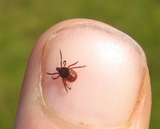
Ticks are parasitic arachnids that wait in vegetation or on rocks or logs for an animal or human to brush up against them. Once contact is made the tick will attach to its host by anchoring into the skin using hook-like mouthparts. Ticks may carry diseases transmittable to humans such as Lyme Disease and should be avoided.
Avoid tick bites by taking proper precautions:
- Stay in the middle of the trail. Avoid trail margins, brushy and grassy areas, leaf-litter, and downed wood or wood products in forested areas where ticks are found.
- Check yourself often for ticks while recreating in parks where ticks may live. Afterwards, thoroughly check your entire body for ticks for several days. Parents should examine their children, especially on the scalp, hairline, and in the belly button after activities in tick-infested areas. If you've brought your dog to the park, make sure to inspect your dog for ticks, as well.
- Wear light-colored long pants and long sleeved shirts, socks, and shoes. The light colored clothes help you to see the ticks.
- Use a repellent registered with the Environmental Protection Agency (EPA) for use against ticks (such as >20% DEET). Always follow directions on the container and be extra careful when applying to children.
- Shower within a few hours after leaving areas where ticks are found and remove any ticks you find on you.
If you, your child or dog are bitten by a tick, make sure to remove the tick as soon as possible. Use tweezers or your fingers to grab the tick close to the skin and pull the tick firmly, straight out. Do not jerk, twist or burn the tick. Wash your hands and the bite site with soap and water after the tick is removed and apply an antiseptic to the bite site.
Taking proper precautions to avoid tick bites is the best protection against tick-borne diseases. Persons who do experience a tick bite should be alert for up to 30 days to symptoms such as fever, rash, redness, swelling, and infection-like or flu-like symptoms. Should these or any other symptoms of concern develop, contact a physician.
Learn more about safety in San Mateo County Parks on our Be Aware page »